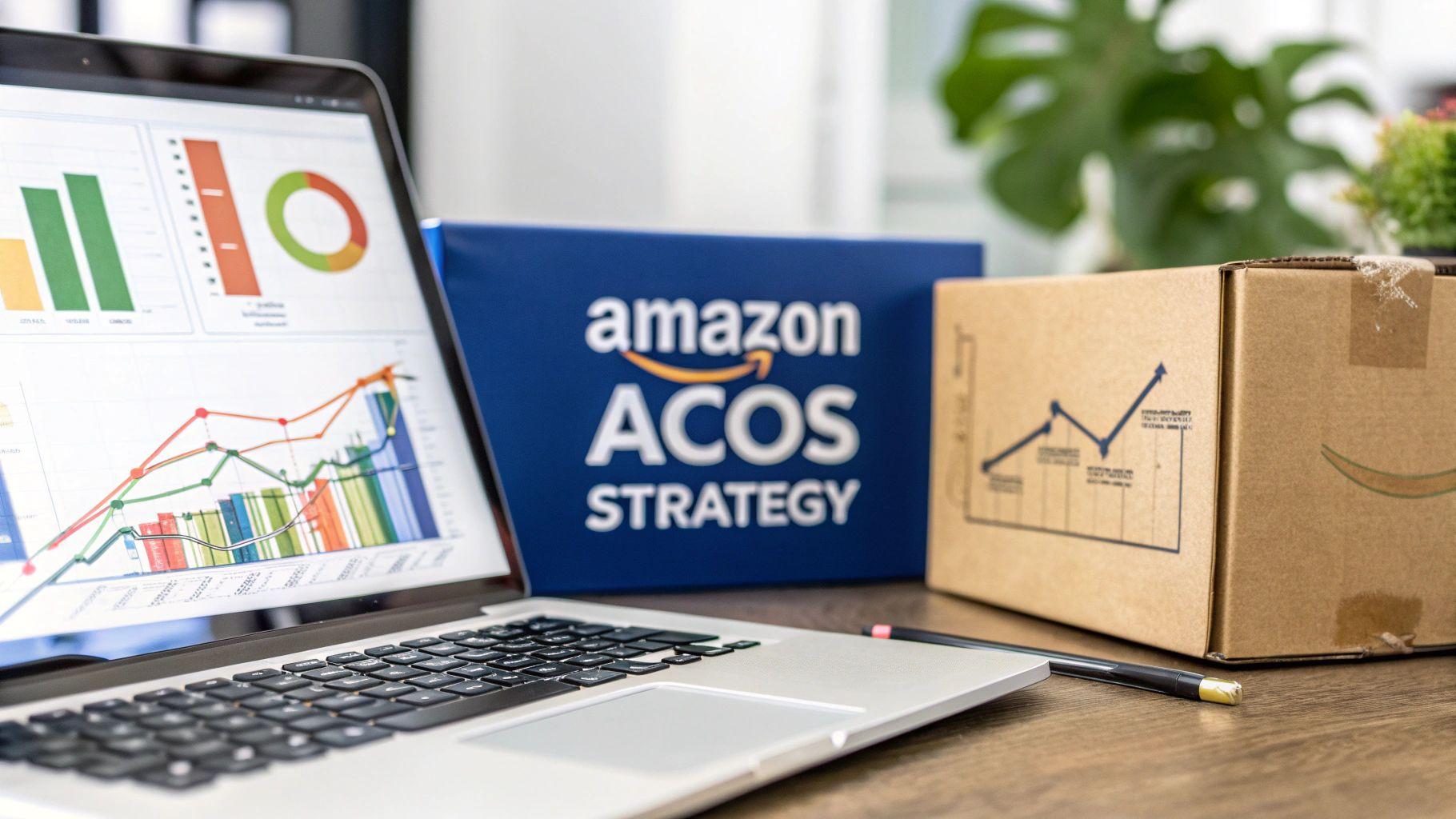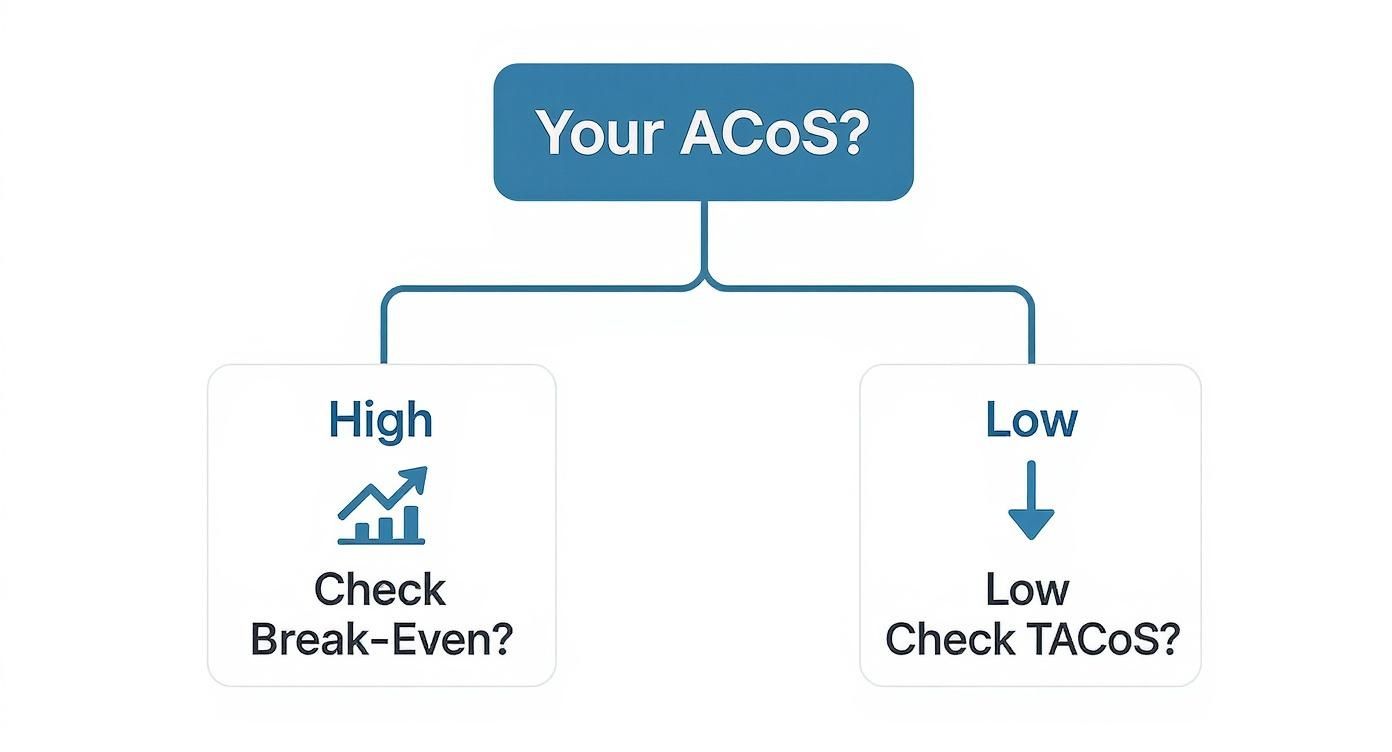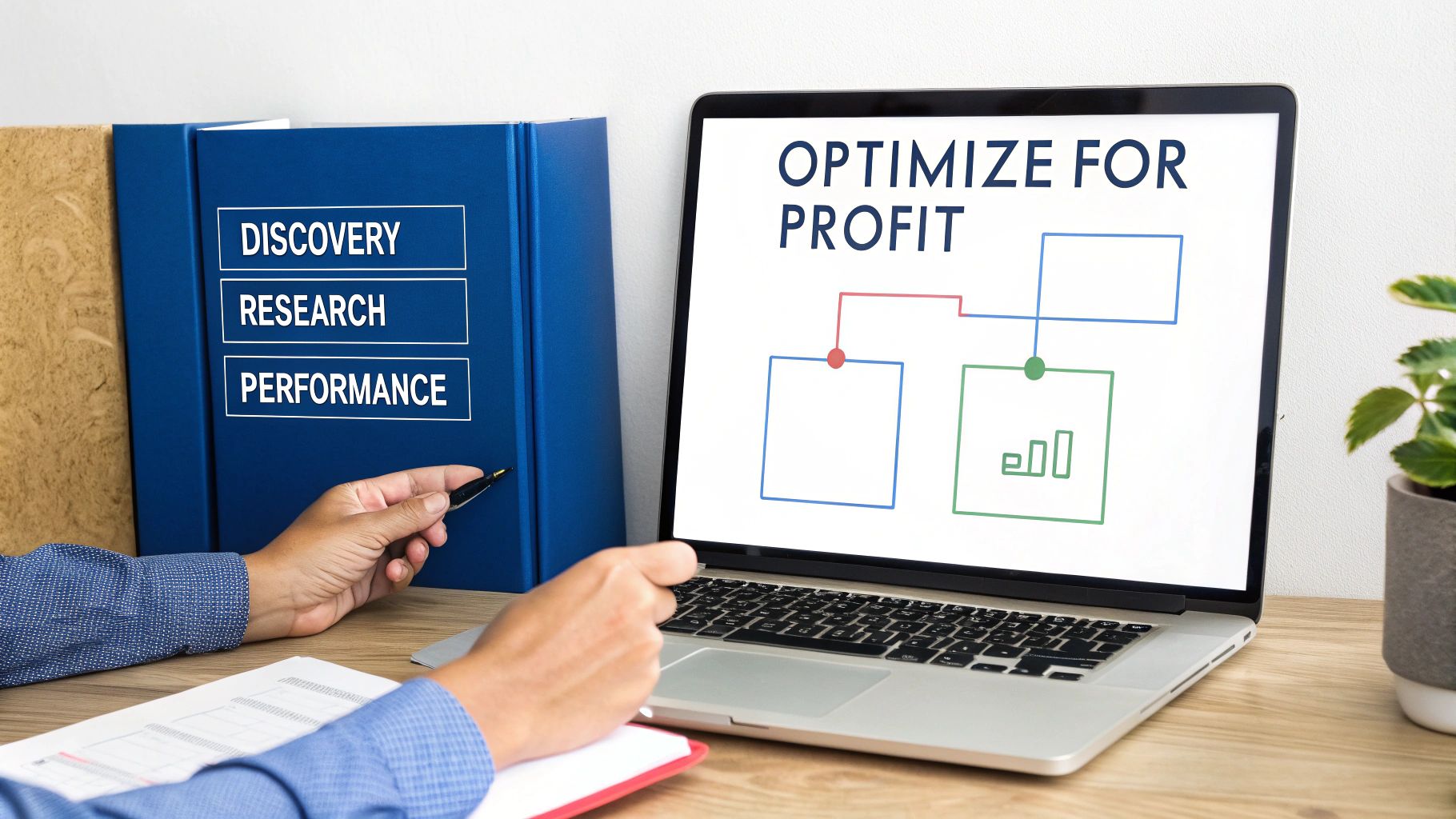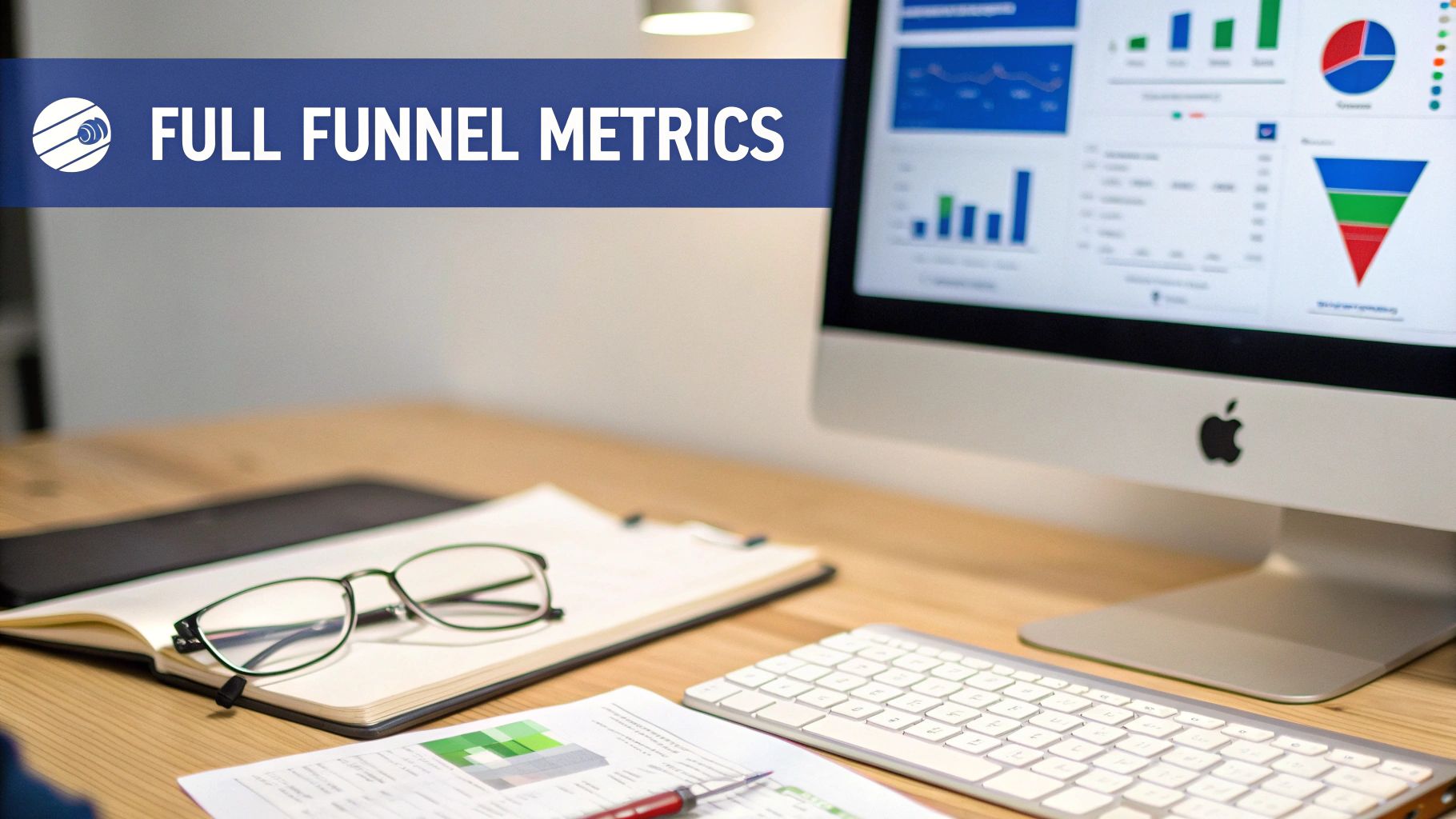A Smarter ACoS on Amazon Strategy for Sustainable Growth
Stop chasing low ACoS on Amazon. Learn what this metric truly means, how to set profitable targets, and use PPC to drive sustainable organic growth.

For years, Amazon advertising has been obsessed with one metric: a low Advertising Cost of Sale (ACoS). This singular focus is a strategic mistake. An obsession with crushing your ACoS on amazon is likely the very thing holding back your growth, costing you market share, and cannibalizing your organic sales.
Why Chasing a Low ACoS Is Costing You Sales
Too many brands view Amazon PPC as an expense line to be minimized. The logic seems sound—spend less on ads, increase profit. But this fundamentally misunderstands the Amazon ecosystem. Advertising on Amazon isn't just an expense; it's a primary investment lever for total business growth.
The brands that win on Amazon have flipped this conversation. They see PPC as the engine for the "flywheel effect." Paid advertising drives sales, which boosts organic search ranking, leading to more organic sales. An ACoS target that's too restrictive starves that flywheel before it can gain momentum.
The Real Cost of a "Good" ACoS
When you aggressively cut bids and budgets to force ACoS down, you're not just saving a few dollars. You're sacrificing visibility. You're ceding digital shelf space to competitors. You are walking away from new customer acquisition opportunities.
Simply put, you're playing defense in a marketplace that massively rewards offense.
This defensive posture is increasingly dangerous. As Amazon becomes more saturated, competition for ad placements intensifies, driving up costs. Data shows average ACoS figures climbing from around 22% in 2021 to nearly 27% in recent years in major markets, a direct result of rising CPCs and more sellers vying for the same shoppers. Discover more insights about market competition on maximizemarketresearch.com.
The Takeaway: ACoS is a measure of efficiency, not a goal in itself. The objective is to build a sustainable, profitable, and growing enterprise. A "good" ACoS is the number that aligns with your current strategic objective—be it launching a new product, defending market share, or maximizing profitability.
This guide provides a practical framework for looking beyond simple metrics to make smarter decisions that connect ad spend directly to what truly matters: long-term, profitable growth.
From Ad Spend to True Profitability
To gain control over your advertising performance, you must look beyond surface-level metrics. It starts with how we define ACoS. The formula is straightforward: Advertising Cost of Sale (ACoS) = Ad Spend ÷ Ad Sales. But stopping there misses the entire picture.
Think of ACoS as a car's MPG. It's a useful metric for knowing how efficiently you’re burning fuel (ad dollars) to generate sales. A low ACoS feels efficient, like high MPG. But that number tells you nothing about whether you're driving toward the right destination: overall profit.
Calculating Your Break-Even ACoS
Before setting any campaign targets, you must know your Break-Even ACoS. This is the line in the sand—the highest your ACoS can be before you start losing money on each ad-driven sale.
To find it, you need your product's pre-ad profit margin. The calculation is simple:
- Pre-Ad Profit Margin = (Sale Price - Cost of Goods Sold - Amazon Fees) ÷ Sale Price
That resulting percentage is your Break-Even ACoS. If your pre-ad profit margin is 40%, your Break-Even ACoS is 40%. Spending more than that on advertising means you are paying Amazon to sell your product at a loss. Getting this right is critical, and we have a detailed guide on how to calculate profit per unit to help you nail down your numbers.
Any ACoS below your break-even point is profitable on a per-unit basis. The strategic question is not just if it's profitable, but how profitable, and whether that level of profit supports your broader business goals.
Introducing TACoS: The True North Metric
The problem with only looking at Break-Even ACoS is that it ignores the "halo effect" of your advertising. Effective advertising does more than drive an immediate click and sale; it boosts your organic ranking and visibility. This is where Total Advertising Cost of Sale (TACoS) becomes your true north.
The TACoS formula measures the bigger picture:
- TACoS = Total Ad Spend ÷ Total Sales (Ad Sales + Organic Sales)
This shift in perspective is critical. It measures your ad investment against your entire Amazon business, not just ad-attributed sales. Why does this matter? Because strong ad performance improves sales velocity, which signals to Amazon's algorithm that your product is a winner, pushing you up the organic search results. This generates more organic sales—the kind you don't pay for.
A healthy, growing brand is one where TACoS trends downward over time, even if ACoS remains steady or increases during a product launch. A falling TACoS is proof that your ad spend is efficiently fueling your organic engine. It’s the clearest indicator of a sustainable business, not just one renting customers. This is the mindset that separates brands that run ads from those that build empires.
Setting Your Target ACoS Based on Business Goals
If you’re using a single, static ACoS target across your entire catalog, you are leaving money on the table. The most sophisticated brands on Amazon treat ACoS as a flexible lever to achieve specific, time-bound business objectives. Your target ACoS should change depending on whether you’re launching, growing, or harvesting profits from a product.
Generic industry benchmarks are worse than useless—they are often misleading. An "average" ACoS of 30% is meaningless without the context of your profit margins, competitive landscape, and current strategic goals. A target designed for profit maximization on a mature product would kill a new launch before it ever gains traction.
Aligning ACoS with Your Product Lifecycle
Your ACoS strategy must adapt to a product's lifecycle stage. A one-size-fits-all approach is a surefire way to waste ad spend and miss critical opportunities.
Launch Phase (High ACoS): The primary objective of a new launch is gaining visibility, driving sales velocity, and securing early reviews. A high ACoS is a necessary investment to buy data and establish a market foothold. Pushing for a low ACoS at this stage is like trying to save gas by never leaving your driveway—you save fuel, but you go nowhere. For example, a new electronics gadget might require a 60-70% ACoS for the first 30 days to rank on page one for core keywords, a strategic loss leader for long-term organic placement.
Growth & Defend Phase (Moderate ACoS): Once a product is established, the focus shifts to scaling sales and defending market share. Your ACoS target should be set just below your break-even point. This strategy drives profitable growth while maintaining an aggressive posture to win bids on high-value keywords. A case study with a client in the competitive supplement space showed that maintaining a 28% ACoS (vs. a 35% break-even) allowed them to increase total sales by 40% in six months while their TACoS dropped from 15% to 9%.
Profitability Phase (Low ACoS): For mature, best-selling products with strong organic rank, the goal is to maximize cash flow. At this stage, you can reduce ad aggression and set a much lower ACoS target. You are no longer buying growth; you are harvesting profits from your established organic presence, using ads to capture only the most profitable, high-intent customers.
Strategic ACoS Target Framework
Choosing the right target ACoS is a strategic decision, not just a mathematical one. The table below connects advertising metrics to core business objectives, helping you shift from reacting to ACoS to proactively managing it.
Strategic ACoS Targets Aligned with Business Objectives
| Business Goal | Target ACoS Range | Target TACoS Focus | Primary KPIs |
|---|---|---|---|
| Product Launch | At or Above Break-Even | Stable or Increasing | Clicks, Impressions, Sales Velocity, New-to-Brand Customers |
| Market Share Growth | Moderately Profitable (e.g., 5-15% below break-even) | Decreasing | Total Sales, Organic Rank, Ad-Driven Sales, TACoS |
| Maximize Profit | Highly Profitable (e.g., >20% below break-even) | Stable and Low | Profit Margin, Total Profit, Return on Ad Spend (ROAS) |
This framework clarifies that ACoS is not just a number to be lowered, but a tool to be aimed at a specific outcome.
This decision tree offers a quick visual guide for the first steps in analyzing your ACoS performance.

The flowchart simplifies the initial analysis. If ACoS is high, the first check is profitability (Break-Even ACoS). If ACoS seems low but total sales are stagnant, it’s time to assess the health of your entire business (TACoS).
Real-World ACoS Benchmarks in Action
What’s considered an acceptable ACoS varies wildly by strategy and category. Top sellers in cutthroat niches like electronics often maintain an ACoS between 15% to 25% to balance aggressive growth with healthy profit margins.
However, a new product launch in that same category might demand an ACoS of 40%-50% or higher. That’s not a mistake; it's a calculated investment to acquire visibility and critical early reviews before dialing back to a more efficient, long-term strategy. You can find more details in these Amazon seller statistics.
The Takeaway: Stop asking "What is a good ACoS?" and start asking "What ACoS will achieve my current business goal?" By matching your targets to a product's specific lifecycle phase—launch, growth, or profit—you turn ACoS from a restrictive metric into a powerful tool for strategic growth. This is the mindset that separates brands that just run ads from those that build empires.
Actionable Strategies to Optimize ACoS for Profit

Knowing your target ACoS is one thing; hitting it while growing your business is another. Success requires more than tweaking bids. It demands a smart, performance-focused campaign framework built from the ground up.
The best strategies provide control, improve efficiency, and are built on a deep understanding of customer behavior. By structuring campaigns with purpose and using Amazon's tools with precision, you can methodically eliminate wasted ad spend, boost conversion rates, and turn PPC into a true profit engine.
Structure Campaigns for Maximum Control
A disorganized campaign structure is the #1 cause of uncontrolled ad spend. To get a real grip on your ACoS on Amazon, segment campaigns based on their specific function. This three-part framework consistently delivers results.
Discovery Campaigns: Use broad match and automatic targeting to cast a wide net and uncover new, high-converting customer search terms and competitor ASINs. ACoS will be higher here—you're paying for market intelligence, not just sales.
Research Campaigns: Once a discovery campaign uncovers a promising keyword, move it to a dedicated phrase match campaign. This is your validation step, allowing you to test the keyword with more targeted traffic and confirm its viability before investing heavily.
Performance Campaigns: Only your proven, top-performing keywords graduate to these exact match campaigns. Here, you can bid aggressively and increase budgets with confidence, knowing every dollar is focused on terms proven to drive profitable sales.
This tiered system moves keywords from an environment of high learning to one of high certainty, giving you pinpoint control over ACoS at every stage.
Leverage Negative Keywords Aggressively
Wasted ad spend is the silent killer of profitability. Every impression for an irrelevant search query is a drain on your budget. Negative keywords are your most powerful tool for plugging these leaks.
Your goal should be to make your ad campaigns smarter every single day. Relentlessly pruning irrelevant search terms ensures your budget is concentrated only on shoppers with the highest purchase intent.
Make it a non-negotiable weekly task to review your search term reports. Any term that is irrelevant, has clicks but no sales, or is for a different product type must be added as a negative exact match keyword. This simple discipline can dramatically improve ACoS. For a deeper dive, our guide on mastering Amazon negative keywords lays out the full strategy.
Employ Sophisticated Bidding Strategies
Not all clicks are created equal. A click from the top of search is far more valuable than one buried on a product page. Amazon allows you to adjust bids based on placement.
Analyze your campaign placement data. If "Top of Search" converts at a significantly higher rate, use a positive bid adjustment—sometimes up to 50% or more—to increase your chances of winning that prime real estate. Conversely, if a placement is consistently unprofitable, reduce your bids there.
And don't neglect the fundamentals. Optimizing ACoS starts with a great product listing. This is especially true for optimizing your Amazon product pictures; better images improve conversion rates, which directly lowers ACoS.
Build a Defensive Moat Around Your Listings
Stop letting competitors steal sales from your own product detail page (PDP). Use Sponsored Display and Sponsored Brands ads to build a defensive moat.
Target your own ASINs with these ad types. This will populate the "Sponsored products related to this item" carousel on your page with your other products. This strategy accomplishes two key goals:
- It blocks competitors from poaching your hard-won traffic.
- It encourages shoppers to browse more of your catalog, increasing cross-sells and average order value.
This is a low-cost, high-impact tactic to protect your conversion rate and keep shoppers within your brand ecosystem.
Measuring Performance Beyond the ACoS Metric

If your performance discussions start and end with the metrics inside the Amazon Ads console, you're flying blind. ACoS and TACoS are vital health checks, but they only tell part of the story. Relying on them alone is like trying to navigate a city with just a street map—you see the immediate block, but you have no view of the highway system.
To make decisions that drive material growth, you must look beyond last-click attribution. You need visibility into the entire customer journey to understand how your Sponsored Products, Sponsored Brands, and Sponsored Display ads work in concert. The standard ad console cannot provide this view.
Uncovering the Full Customer Journey with Amazon Marketing Cloud
This is where a tool like Amazon Marketing Cloud (AMC) becomes a game-changer. AMC is a secure data clean room where you can analyze signals from across the Amazon ecosystem—ad campaigns, retail activity, and more. It is designed to answer complex questions that the basic dashboard cannot.
For instance, you can finally map how a shopper who viewed your Sponsored Brands video ad later returned to convert through a Sponsored Products ad. This allows you to understand the true, combined impact of your advertising and give proper credit to upper-funnel efforts.
With AMC, you can build a much richer picture of performance by:
- Analyzing path-to-purchase reports to map the exact sequence of ad interactions leading to conversion.
- Understanding audience overlap to see if you're hitting the same shoppers with different campaigns, causing ad fatigue.
- Measuring the halo effect of ads on organic sales with greater accuracy.
This deeper analysis shifts your focus from managing an ACoS on Amazon to orchestrating a full-funnel strategy that fuels genuine business growth.
Tying PPC Performance to Organic Growth
Another incredibly powerful—and often underutilized—tool is the Search Query Performance (SQP) dashboard. This is where you connect the dots between paid advertising and organic search rank, unlocking the heart of the flywheel effect.
The SQP dashboard provides brand-level data on the top search terms driving impressions, clicks, and sales, broken down by organic and paid performance.
By analyzing SQP data, you can identify high-volume keywords where your ads are performing well but your organic rank is weak. This is a clear, data-backed signal to increase ad spend on that query, drive more sales, and begin climbing the organic ladder.
This transforms your PPC campaigns from a simple sales channel into a strategic weapon for building long-term organic dominance. It’s an insight your competitors, who are stuck chasing a low ACoS, will completely miss. While many sellers obsess over averages, the real win is in this connected approach. For context, the average ACoS for Sponsored Products ads hovers around 27%, but this can swing wildly, with tough categories like apparel often hitting 35% or more. You can read a full analysis on Amazon's official seller blog.
The ultimate goal is a holistic framework connecting every ad dollar to its total impact on your business. By integrating insights from AMC and the SQP dashboard, you can move beyond surface-level metrics and start making decisions that drive real, sustainable scale. Learn more about how this connects to the big picture in our guide on how to calculate TACoS.
Your Path to Sustainable Growth on Amazon
It all boils down to one truth: ACoS is a compass, not the destination. The objective is to build a strong, profitable brand.
Success isn't a low ACoS on a report; it's sustainable growth that drives real profit. To get there, you must shift from being an ad manager obsessed with a single metric to a business leader focused on total profitability. This means viewing ad spend as an investment designed to ignite the flywheel: paid sales boost product ranking, which leads to more organic sales, creating a powerful, self-sustaining loop.
From Metric-Driven to Mission-Driven
Your goal isn't just to lower your ACoS on Amazon; it's to use it as a strategic lever. It's understanding when to push ACoS higher—like during a product launch to capture market share—and when to pull back and harvest profit from established bestsellers.
This requires looking beyond the ad console and connecting paid campaigns to organic sales, using tools like the Search Query Performance dashboard to see the full picture. When you adopt this mindset, advertising ceases to be an expense and becomes your most powerful tool for growth.
Final Takeaway: Stop chasing a "good" ACoS and start building a great business. When you align your ad strategy with your core business objectives—launching, growing, or maximizing profit—you create a cycle of sustainable growth that anchors your brand on Amazon for years to come.
For brands ready to move beyond basic metrics and build a truly sophisticated, profit-driven advertising strategy, the right partner can make all the difference. A data-first agency ensures every dollar spent is a strategic investment in your long-term success.
Answering Your Top Amazon ACoS Questions
You need straight, no-nonsense answers to your most pressing ACoS questions. Let's cut through the fluff.
What Is a Good ACoS Percentage on Amazon?
There is no universal "good" ACoS. The right number is entirely dependent on your product's profit margin and your current business objective. The oft-quoted 30% benchmark is meaningless without context.
- For Profitability: A great ACoS is one well below your break-even point. For established products, a target in the 20-25% range often signals healthy profitability.
- For Growth/Launch: A "good" ACoS might be at or even above your break-even point. This is a strategic investment to capture market share, build sales velocity, and boost organic rank.
The correct question isn't "What's a good ACoS?" but "What ACoS is required to achieve my current goal?"
How Are ACoS and ROAS Different?
They are two sides of the same coin, measuring the exact same thing from opposite perspectives.
- ACoS (Advertising Cost of Sale) measures cost as a percentage of revenue (Ad Spend ÷ Ad Sales). Lower is better.
- ROAS (Return on Ad Spend) measures revenue generated per dollar of ad spend (Ad Sales ÷ Ad Spend). Higher is better.
A 25% ACoS is identical to a 4.0x ROAS. While both are useful, ACoS is the standard metric within the Amazon ecosystem.
Can I Automate My ACoS Optimization?
Yes, and you should. Manually adjusting bids across thousands of keywords is inefficient and prone to error. Smart automation is key to hitting ACoS targets at scale.
But automation is only as effective as the human strategy guiding it. Simply enabling a tool with the goal to "lower ACoS" will likely throttle sales and stunt growth.
The optimal approach is a partnership between human strategy and machine execution. You define the strategic objective—launch a product, defend market share, maximize profit—and empower automation to execute the thousands of micro-adjustments required to achieve it.
This ensures technology serves your business strategy, not the other way around.
At Headline Marketing Agency, we transform ad spend into a strategic growth driver. We move beyond basic ACoS targets to build holistic Amazon advertising programs focused on true profitability and long-term scale. Discover how our data-driven approach can grow your brand.
Wollen Sie Ihre Amazon PPC-Performance aufs nächste Level bringen?
Lassen Sie Ihre Amazon PPC-Kampagnen professionell analysieren und entdecken Sie neue Wachstumsmöglichkeiten.